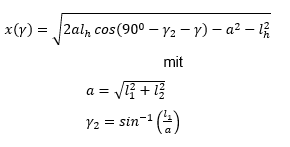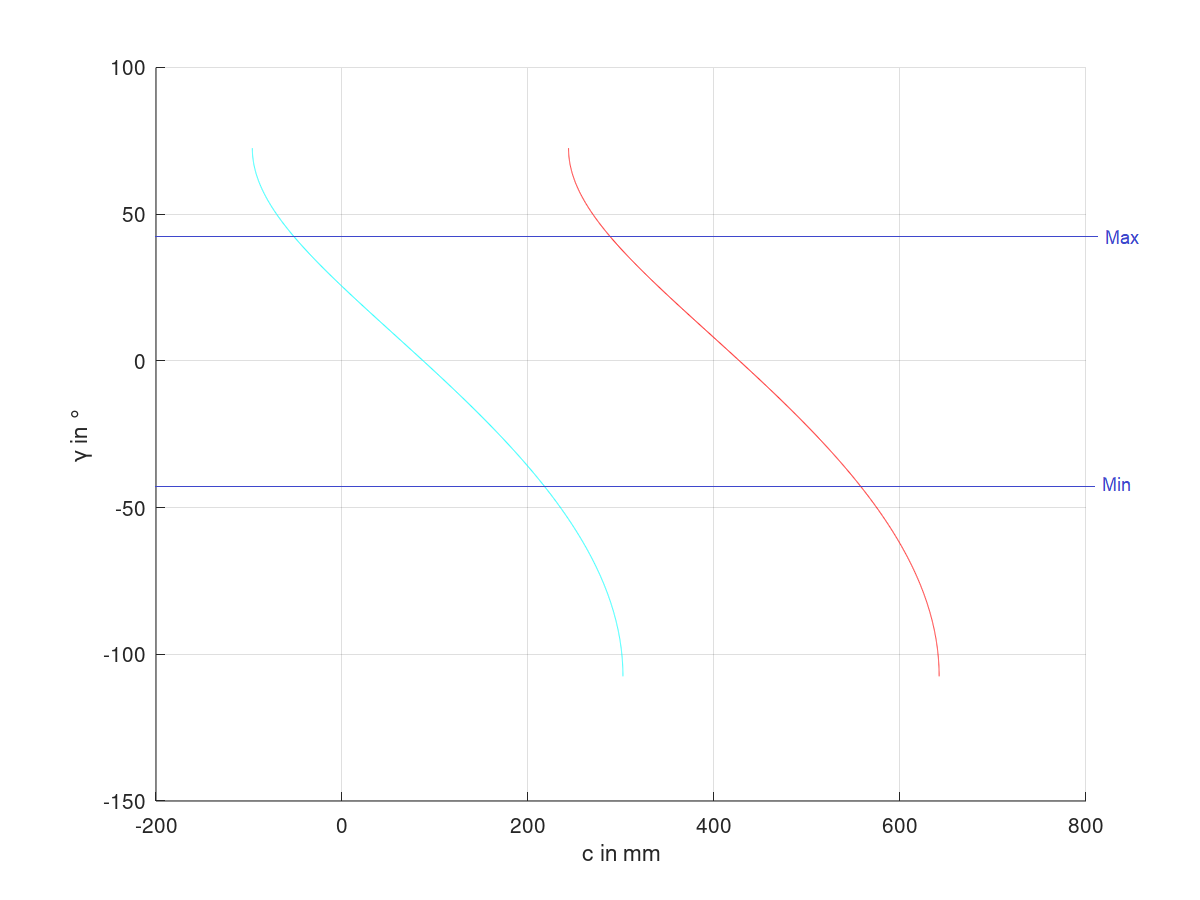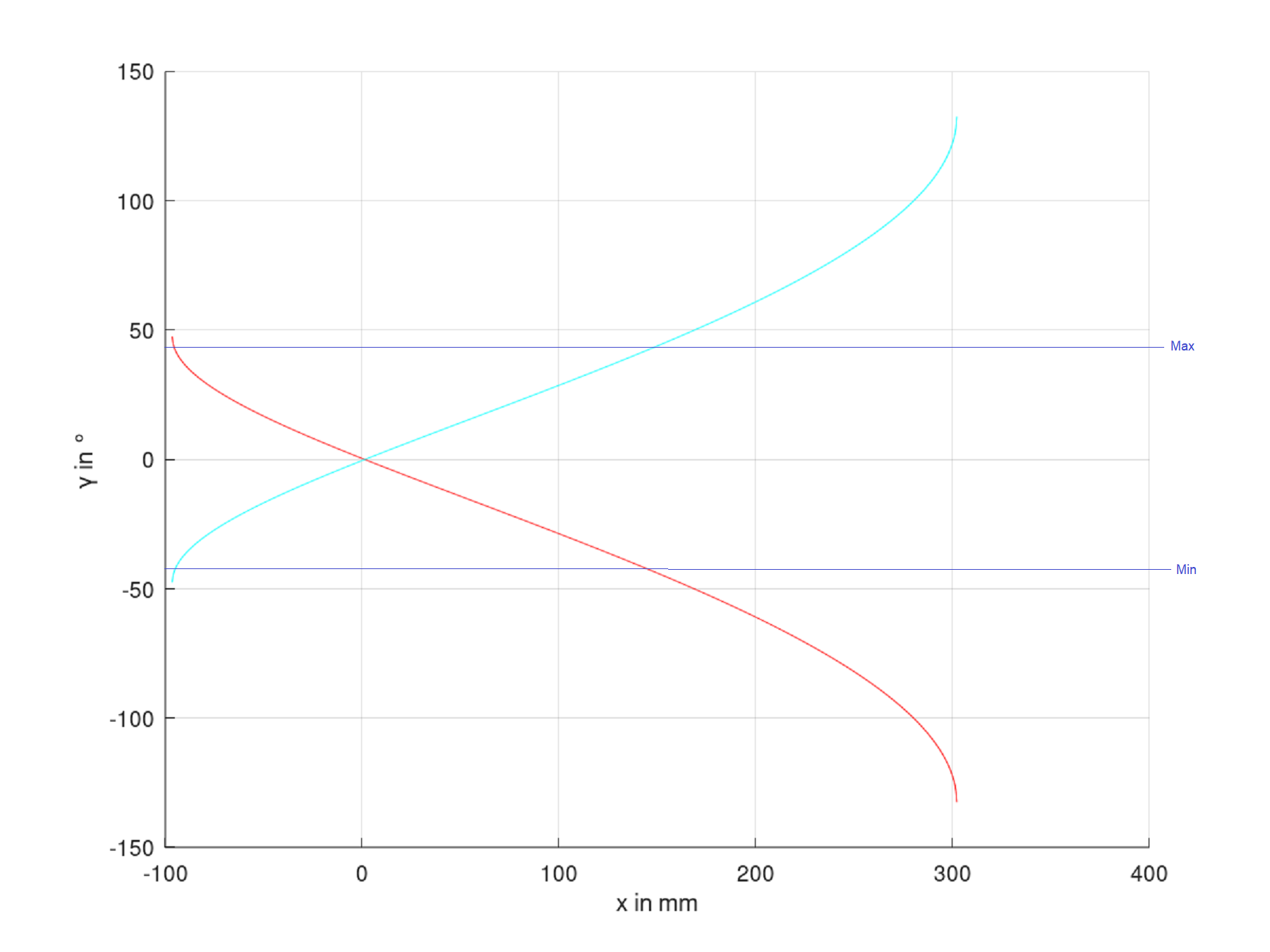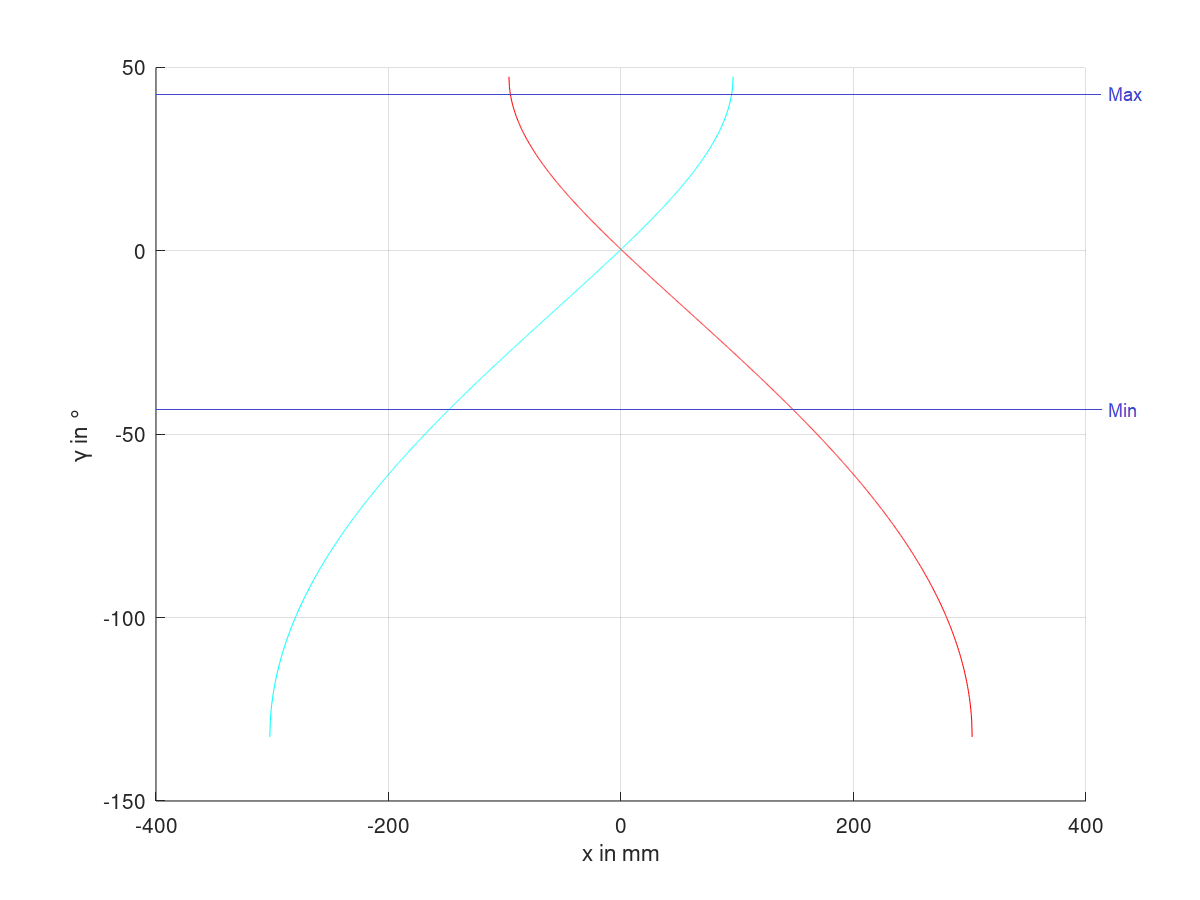Transformation types
ID 1: e function


Example:
trafo.command_pos.param[0] 10000 (h)
trafo.command_pos.param[1] 1.0 (k0)
trafo.command_pos.param[2] 2.0 (k1)
trafo.command_pos.param[3] 1.0 (k2)
trafo.command_pos.param[4] 1800000 (normalisation of motor angle)

ID2: Crank


Example:
trafo.command_pos.param[0] 1000000 (crank length l1)
trafo.command_pos.param[1] 3000000 (con-rod- length l2)
trafo.command_pos.param[2] 0 (eccentricity e)
trafo.command_pos.param[3] 0 (solution range for motor angle)
trafo.command_pos.param[3] 0 (movement direction of linear axis)

Notice

In the event of eccentricity e != 0 and specific parameter settings (e.g. (l2-l1) < e), there may be limits to the motor angle movement range because of jamming in the kinematic structure. In this case, the motor angle movement range of both solutions is smaller than 360 degrees (see figure below).

ID3: Eccenter



Example:
trafo.command_pos.param[0] 1000000 (eccenter radius R)
trafo.command_pos.param[1] 0 (offset zero position linear axis)
trafo.command_pos.param[2] 0 (offset zero position rotary axis)
trafo.command_pos.param[3] 0 (solution range angle)
ID4: Crank with linkage by linear axis

Example:
trafo.command_pos.param[0] 1000000 (distance la joint point)
trafo.command_pos.param[1] 1410000 (distance lb joint point)
trafo.command_pos.param[2] 1000000 (crank length lh)
trafo.command_pos.param[3] 0 (offset zero position)
trafo.command_pos.param[4] 0 (movement direction of rotary axis)

If the kinematic (β=0) is in zero position, the transformation delivers the drive position 0 for ls. If necessary, by param[3] an offset to this position can be defined. (Example: Drive position at β=0 is 50mm -> the offset value has to be set on 50mm). Mathematically, the default rotational direction of the B axis is positive. This can be adapted by the parameter trafo.command_pos.param[4], see figure below.

ID5: Angular kinematic
Available as of CNC Build V3.1.3107.41/V4.3.0.
A linear movement results from the angular movement.
The parameters specify the lengths l1,l2 and lh. The maximum excursions are defined by the parameters γmax and γmin.


Example:
trafo.command_pos.param[0] 1900000 (length of distance l1)
trafo.command_pos.param[1] 600000 (length of distance l2)
trafo.command_pos.param[2] 4428300 (length of distance lh)
trafo.command_pos.param[3] -450000 (angle excursion lower limit γmin)
trafo.command_pos.param[4] 450000 (angle excursion upper limit γmax)
trafo.command_pos.param[5] 0/3400000 (position offset)
trafo.command_pos.param[6] 0 (angle offset)
trafo.command_pos.param[7] 0 (angle inversion)
trafo.command_pos.param[8] 0 (linear position inversion)
Below is the transfer function with and without position offset
Red: without position offset
Light blue: with posi8tion offset

Angle offset and angle inversion
In addition to the example above, the angle can be provided with an angle offset by parameters and can also be inverted.
trafo.command_pos.param[0] 1900000 (length of distance l1)
trafo.command_pos.param[1] 600000 (length of distance l2)
trafo.command_pos.param[2] 4428300 (length of distance lh)
trafo.command_pos.param[3] -450000 (angle excursion lower limit γmin)
trafo.command_pos.param[4] 450000 (angle excursion upper limit γmax)
trafo.command_pos.param[5] 3400000 (position offset)
trafo.command_pos.param[6] 250000 (angle offset)
trafo.command_pos.param[7] 0/1 (angle inversion)
trafo.command_pos.param[8] 0 (linear position inversion)
The following transfer function is with and without angle inversion.
Red: without angle inversion
Light blue: with angle inversion

Linear position inversion
Based on the example above, the linear position can be inverted.
trafo.command_pos.param[0] 1900000 (length of distance l1)
trafo.command_pos.param[1] 600000 (length of distance l2)
trafo.command_pos.param[2] 4428300 (length of distance lh)
trafo.command_pos.param[3] -450000 (angle excursion lower limit γmin)
trafo.command_pos.param[4] 450000 (angle excursion upper limit γmax)
trafo.command_pos.param[5] 3400000 (position offset)
trafo.command_pos.param[6] 250000 (angle offset)
trafo.command_pos.param[7] 0 (angle inversion)
trafo.command_pos.param[8] 0/1 (linear position inversion)
The following transfer function is with and without linear position inversion.
Red: without linear position inversion
Light blue: with linear position inversion

As a general rule, the following applies:
The specified angle of the kinematic has mathematical limits due to the specified input variables. If they are not observed, error ID 70342 is output.
ID 6: Symmetrical slider crank
In addition to identical lengths of crank and con-rod, this structure has an additional mechanical coupling between these elements so that no mechanical jamming can occur in the centre position of the slider (linear position).
Symmetrical slider crank solution range 0 to 180 degrees:
Symmetrical slider crank solution range 180 to 360 degrees:
Example:
trafo.command_pos.param[0] 1500000 (con-rod length == crank length)
trafo.command_pos.param[1] 0 (linear position offset)
trafo.command_pos.param[2] 0 (angle position offset)
trafo.command_pos.param[3] 0 (angle solution range)
Transfer function φ= f(x)








